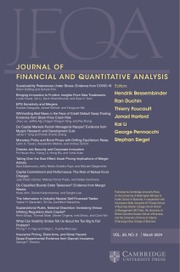No CrossRef data available.
Article contents
Dynamic Adverse Selection and Belief Update in Credit Markets
Published online by Cambridge University Press: 01 April 2024
Abstract
We develop a dynamic model of debt contracts with adverse selection. Entrepreneurs borrow investment goods from lenders to run businesses whose returns depend on entrepreneurial productivity and common productivity. Entrepreneurial productivity is the entrepreneur’s private information, and lenders construct beliefs about entrepreneurial productivity based on the entrepreneur’s business operation history, common productivity history, and the terms of the contract. The model provides insights into the dynamic and cross-sectional relations between firm age and credit risk, persistency of the effects of a productivity shock, cyclical asymmetry of the business cycle, slow recovery after a crisis, and constructive and destructive economic downturns.
Information
- Type
- Research Article
- Information
- Creative Commons
- This is an Open Access article, distributed under the terms of the Creative Commons Attribution licence (http://creativecommons.org/licenses/by/4.0), which permits unrestricted re-use, distribution and reproduction, provided the original article is properly cited.
- Copyright
- © The Author(s), 2024. Published by Cambridge University Press on behalf of the Michael G. Foster School of Business, University of Washington
Footnotes
We would like to thank John Nachbar, Peter Norman, Stephen Williamson, Randall Wright, and all seminar participants at the 2020 World Congress of the Econometric Society, 2021 Society for the Advancement of Economic Theory, 2021 World Congress of the Game Theory Society, 2021 Australasian Meeting of the Econometric Society, and 2021 Korean Economic Review International Conference for helpful comments. Finally, we thank the anonymous referee and Ran Duchin (the editor) for constructive comments and suggestions that have greatly improved the paper.

